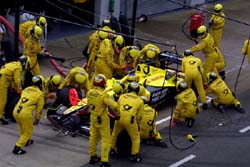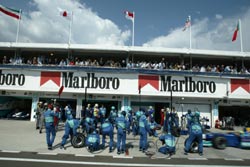 A pit stop is a pit stop, right? Car races in, four wheels
changed, some fuel put rapidly into the tank and away she goes. Admittedly, it's
on the quick side; ten seconds for a slow change and close to seven for a fast
one. In the time the average motorist takes to find their keys Michael Schumacher is burbling away
down the pit lane. But is it really that simple?
A pit stop is a pit stop, right? Car races in, four wheels
changed, some fuel put rapidly into the tank and away she goes. Admittedly, it's
on the quick side; ten seconds for a slow change and close to seven for a fast
one. In the time the average motorist takes to find their keys Michael Schumacher is burbling away
down the pit lane. But is it really that simple?
In fact pit stops have become a real art. It is not just the speed of the stop but when you do it that counts for so much. Calculating which lap to make the stop has become an exact science which, when done well, can leapfrog you up the field and into the points, onto the podium perhaps, or even conjure a victory as Ferrari have shown so often in the past.
Done badly, as Ferrari have also shown when Eddie Irvine had to wait around for his fourth wheel a few years back, they can turn a promising race into an embarrassing farce.
With overtaking as difficult as it is these days, technical directors have been forced to become part army general as they 'wage war', with everything hanging not only on speed, but also strategy. The process is not done by intuition, inspired guesswork or on a wing and a prayer on what "feels right".
"Race strategy always starts by looking at the lap times on different fuel loads," explained Ferrari technical director and ace tactician Ross Brown.

"Roughly speaking ten kilos of fuel costs you between a quarter and
three-tenths of a second a lap. Or put another way a car uses three kilos of
fuel per lap. If you work that out you get an idea of whether it should in
theory be a one, two or three stop race."
"Then you have to factor in tyre consistency. On some tracks the performance
of the tyre does not fall away too drastically and in others it does. In
Montreal and Monza, for example, the tyre degradation is pretty stable so you
run as far as the car and fuel will let you. You know that if the tyre
performance stays constant as the fuel load drops you are going to go faster and
faster until you pit. So engine consumption becomes a factor. If you have a more
economic engine you can wait until the guy in front of you pits, put in a couple
of fast laps on a lighter load and come out in front of him. That's the theory
anyway."
"If the tyre wear is bad the car may be getting lighter and faster but that
benefit is lost because of the reduced performance of the rubber. Of course the
characteristics of the car have to be borne in mind too. One tyre can be slower
but more reliable and consistent during a race. The other may be faster in
absolute terms but because that cannot be maintained, the drop off in
performance and the added pit stops it requires destroy any inherent advantage."
"Then, of course, you also have to allow for the length of the pit lane. The
last race for example, Hockenheim, has one of the shortest pit lanes in the
season, Silverstone a couple of races before that has the longest."
A long pit lane means the cars will spend longer burbling along at 80kph and nullify the benefits of the speed from running on a low fuel load. But remember, the pit-lane timers do not measure the amount of time a car is stationery in the team garage - that is only done to hype up the moment and crystallise in drama for the television viewer. They measure the time each car cuts the 80kph speed limit beam on the way in, to the time they cut it on the way out.
The statistics show the difference between Hockenheim and Silverstone. David Coulthard had the shortest pit stop in Germany, refuelling in 28.676 seconds, then it was Montoya on 28.864 and Sato on 29.075. Winner Michael Schumacher was fourth fastest, dispatched in 29.099 seconds.
Interestingly the time sheets allow the teams to quantify exactly the time lost in a pit-stop bungle. For example, in the German GP Rubens Barrichello pitted first time around in 29.701s - seventh quickest. But on his second stop the fuel flap jammed and he had to open it from his cockpit switch. The stop took 42.445s. So the confusion cost the Brazilian 12.744s. That is not small gap - that is a Grand Canyon of a mistake.
In Britain Coulthard was again the fastest, this time in 31.151 seconds, and second fastest (31.236), followed by Barrichello (31.463), shading Bernoldi (31.468) and Massa (31.469). The worst stop was down to Raikkonen (1m 02.575s), which meant 31 seconds was wasted.
Even where you are in the pit lane has a tactical relevance. "If you are up
at the start of the pit lane you can see ahead of you everything that is going
on," explained Ross Brown. "There is a psychological advantage in that for the
driver. If you are at the other end, everything is happening behind you."
"It sounds obvious but in general if you are the car in front, you are trying
to keep the guy behind you. If you are behind you want to get in front."
"That's where a bit of skulduggery comes in. If you are in the car in front
you then delay him (the car behind) as much as you can and he loses the
advantage of his speed. But imagine it is the other way around. You are in a
faster car than the guy in front but cannot pass and your car is no more
economical than his. You are both going to have to pit at the same time roughly
speaking and he knows that. All he has to do is stay ahead and then pit when you
do."
"Your options, though, are bleak. You either rely on a super quick 'in' lap,
his mechanics' mistake in the pit lane or you can try to sell a little dummy now
and gain. As he comes around to the pit lane entrance you send your guys rushing
out early and hope to sucker him into stopping before he was planning to. That
clears the track for you to put in the quick laps you need to get out in front
of him."
"You also weigh up the fact that some teams, like McLaren, are traditional one-stoppers, so you build
that into your thinking too."
Of course nothing in the modern age happens without computers and in the pit stops too they play a vital part. "After qualifying we feed in the best lap of every car, look at their tyre deterioration and calculate when we expect them to make their stops," said Ross. "That is important for race planning and getting an idea of what everyone might roughly be thinking of doing. And we do the same after five laps of the race when the performance has settled down a bit."
So that's when you get an idea of which cars are on the harder compound and which are on the soft? This question provoked a smile from Ross. "All the teams usually know who is using what tyre before the race starts," he added.
Other factors come into play too. Drivers can run their engines leaner using one of the various switches on their dashboard. That will keep them out on the track longer - but at the expense of performance.
The surface of course dictates the tyre-wear rates and varies little from year to year. Hungary, for example has a high wear rate and the trick is to stop when the car behind stops. But when your rival stops in Monza or Montreal you put the hammer down and try to build an advantage.
There is such scope for blunders in front of millions of television viewers that the tension and pressure are enormous. Surely no-one involved enjoys the pit stops?
"I do actually," admitted Ross. "In fact I think a lot of the teams and their mechanics do. When you get a rainy day or the pace car coming in and out and you have just a tenth of a second to make a decision, that is fun."
It was in just such a scenario at the Austrian Grand Prix that the calculating brain of Anderson spotted an opportunity. A swift stop for Giancarlo Fisichella got the little Italian up to sixth and his speed turned that into fifth place and Jordan's first points in what had, until then, been a season of unfulfilled promise. That's the difference a pit stop can make.